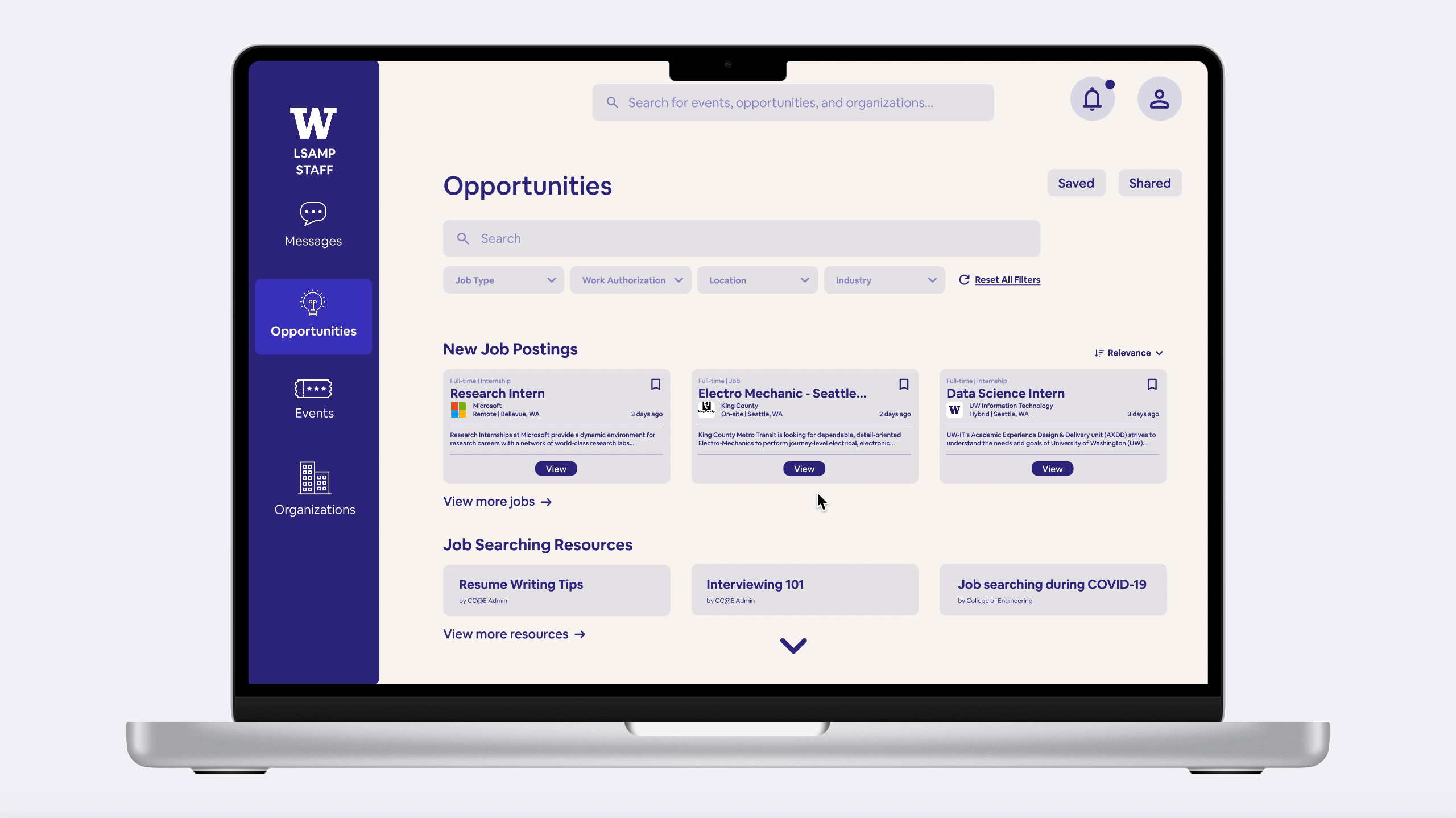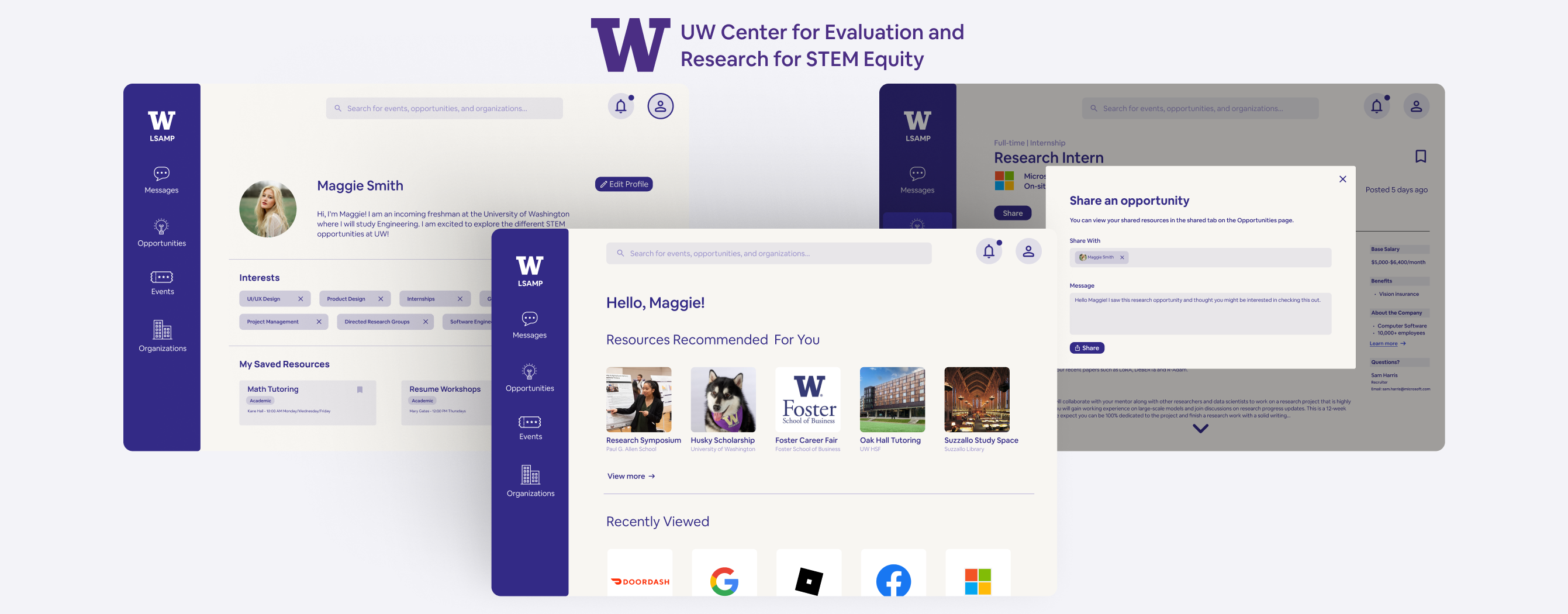

For my HCDE Senior Capstone, my team and I partnered with UW CERSE (UW Center for Evaluation & Research for STEM Equity), a research center at the University of Washington, Seattle. The focus of our capstone project was to produce an interactive platform to connect students, staff, and faculty to campus resources supporting equitable student success in STEM.
Timeframe
January - June 2023
Team
Key Contributions
Client Context
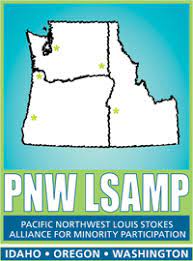
Map of PNW LSAMP
The UW Center for Evaluation & Research for STEM Equity, or UW CERSE, is a team of researchers who focus on conducting research to improve equity and broaden representation in STEM fields in higher education. Their current research is focusing on the PNW LSAMP (Pacific Northwest Louis Stokes Alliance for Minority Participation), a university program consisting of several universities and community colleges from Washington, Oregon, and Idaho whose mission is to support underrepresented students pursuing a bachelor's degree in STEM.
The UW Center for Evaluation & Research for STEM Equity, or UW CERSE, is a team of researchers who focus on conducting research to improve equity and broaden representation in STEM fields in higher education. Their current research is focusing on the PNW LSAMP (Pacific Northwest Louis Stokes Alliance for Minority Participation), a university program consisting of several universities and community colleges from Washington, Oregon, and Idaho whose mission is to support underrepresented students pursuing a bachelor's degree in STEM.
From their research, they've observed that efforts related to improving STEM equity are often siloed, hard to locate, and sometimes provide gaps in the types of support that students need. Our team's task was to learn about where these gaps occur, and alleviate this issue by creating an interactive STEM resource hub platform.
Design Question
How might we design a platform that encourages students and staff to take advantage of the various STEM resources on campus, and make finding these opportunities easier and seamless?
Product Deliverable
Extensive research, ideation, and testing brought us to our developed resource hub website prototype, as showcased in the product video below. UW SERCH (STEM Equity Resource Community Hub) is a virtual extension of the UW LSAMP Center, spotlighting STEM opportunities, events, and resources in a centralized platform while creating opportunity for interpersonal connections and communication between staff and students.
UW SERCH product video
Our Impact
By using UW SERCH, students can find research opportunities, get academic support, and connect with their peers. Staff are able to foster interpersonal relationships with students, improving student advising efforts and building community. There is also the opportunity for facilitated collaboration between efforts from various campus organizations to increase equity in STEM.
While the development of the STEM resource hub is still in progress, our work was able to provide
UW CERSE with more insight regarding the types of resources and opportunities that LSAMP students and staff want to see
in a resource hub, as well as give direction for further iterations of a more-detailed platform by expanding the scope to include the other schools that are part of the PNW LSAMP. Our hope is that the UW SERCH platform will flourish into a go-to resource for students and staff to find information about the various efforts on campus that were created to help support their academic success.
Overarching Research Goals
1. Understand what types of STEM resources and opportunities users are interested in
2. Understand users' current comfort level with finding and sharing STEM resources
3. Understand roadblocks to finding STEM resources
User Research: Surveys - the 'who' and the 'what'
Our team wrote up and sent out a survey to understand Research Goals #1 and #2. We wanted to discover what STEM resources students and staff generally look for, what methods are used to access STEM resources, how accessible resources are, and what features they would like to see in a resource hub platform.
81.8% of surveyed students preferred using a website over mobile or word of mouth.
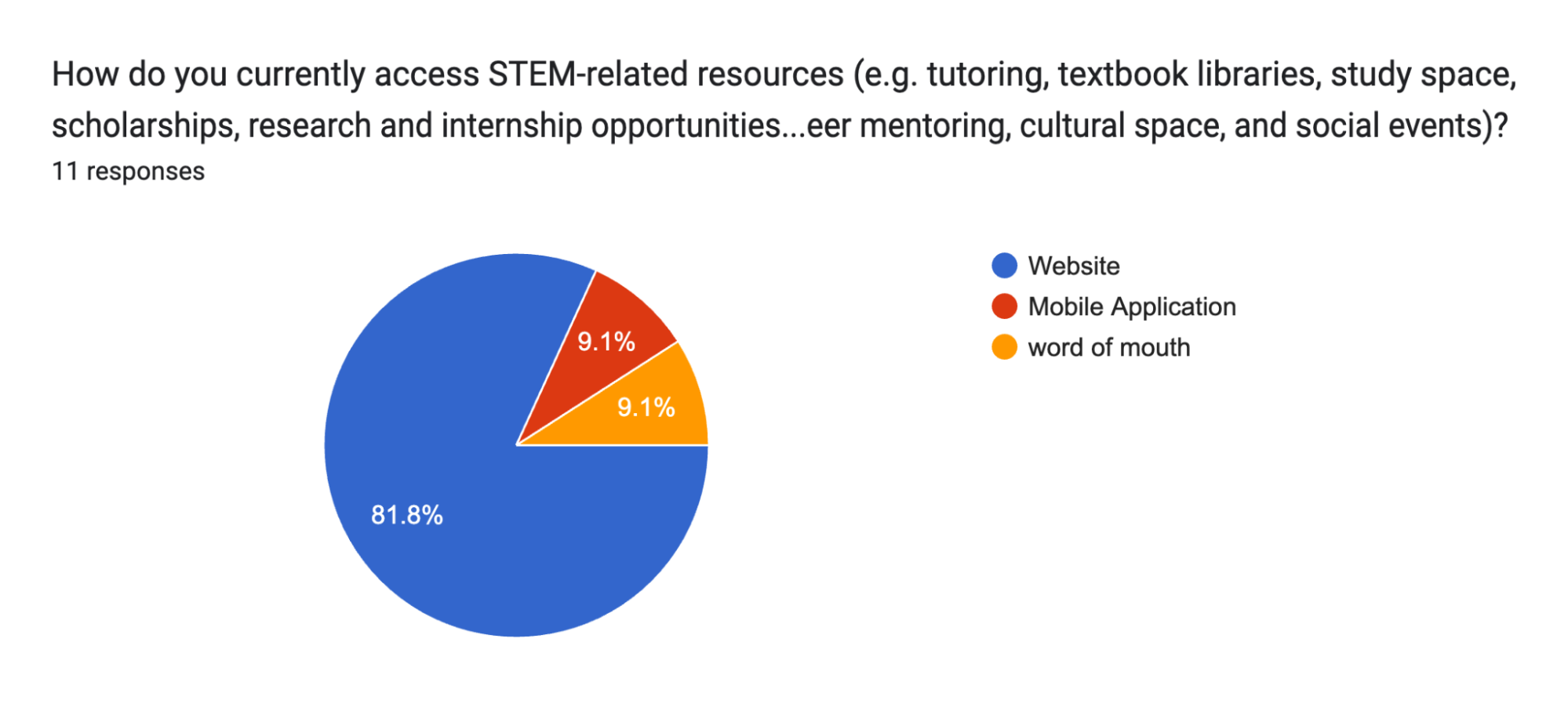
Almost half our participants' experiences indicates that there is opportunity to improve the accessibility or resources.
This supports the purpose of our capstone project, as we are seeking to make the experience of finding STEM resources more efficient, seamless, and accessible.

Additional Survey Insights
Students seek out resources for professional and personal growth:
Platform suggestions:
User Research: Interviews
Our team also conducted 4 interviews to dig deeper on the findings from the survey and discover what roadblocks students and staff face during the process of locating STEM resources. Our team interviewed LSAMP staff as well as a couple students that had filled out our survey indicating they were interested in participating in a follow-up interview.
Interview Questions
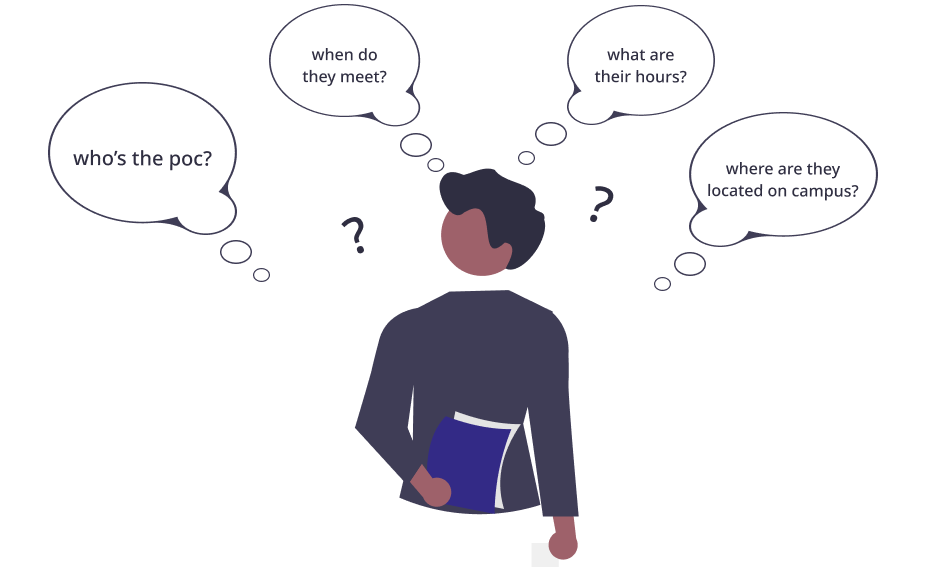
Where do you find who to contact?
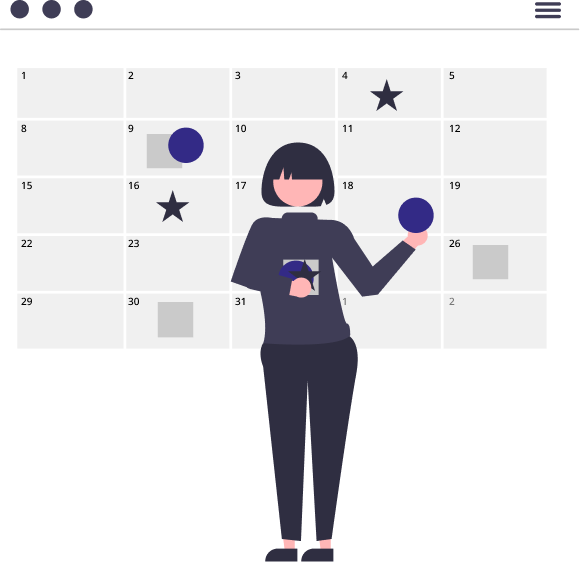
Many resources = a lot of info to track

Where do you find who to contact?

Searches often end up going down a rabbit hole
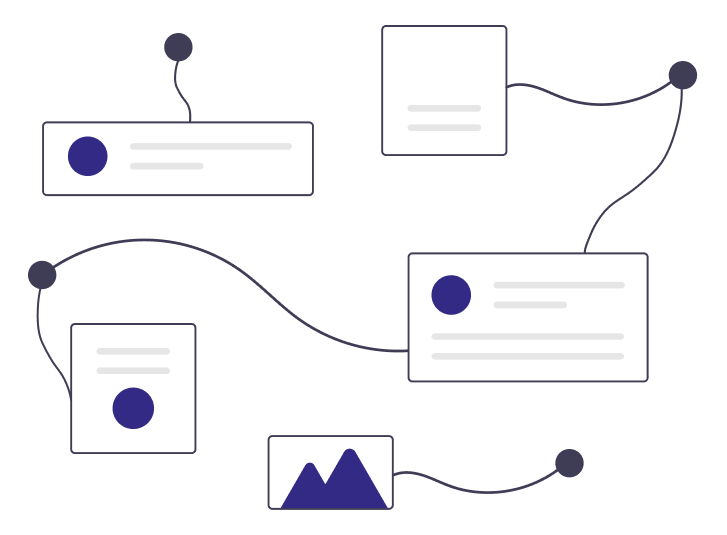
Lack of centralization
Research: Competitive Analysis
We analyzed 8 existing platforms and student organizations, looking at the accessibility of the platform/student organization (the effectiveness of their utilization of technology platforms, such as websites or mobile apps, to share STEM resources), interactivity with other users within the community, and intuitiveness to navigate the platform.

Overall Strengths
The platforms and student organizations generally focus on diversity and inclusion of their audience, creating space for social engagement, networking, and collaboration.
Overall Weaknesses
Patterns of requiring fees to access, calendars that are not up to date, difficult navigation/search, and outdated resources were what we wanted to improve through our platform.
Overall Strengths
The platforms and student organizations generally focus on diversity and inclusion of their audience, creating space for social engagement, networking, and collaboration.
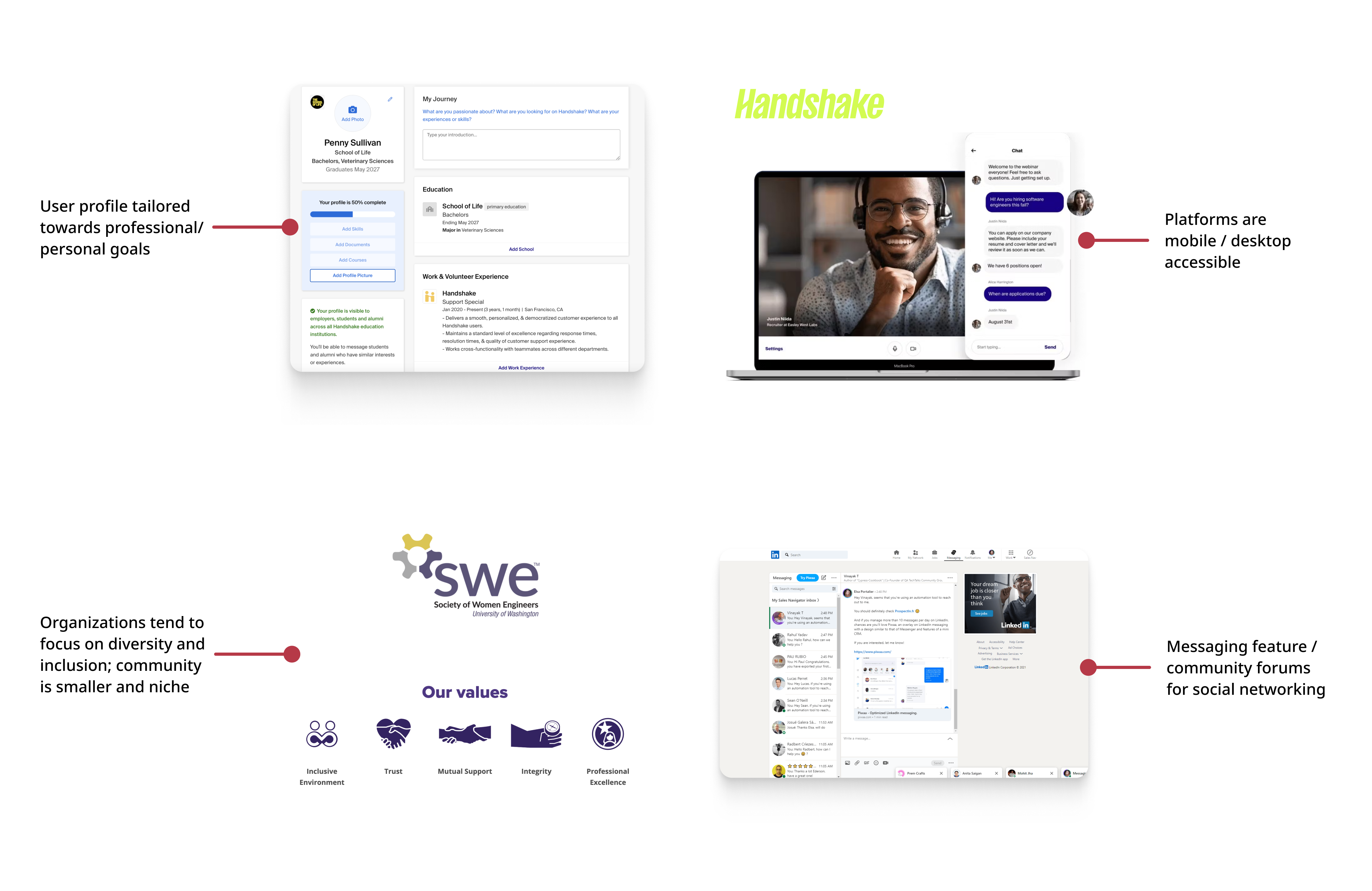
Competitive Analysis: Strengths
Overall Weaknesses
Patterns of requiring fees to access, calendars that are not up to date, difficult navigation/search, and outdated resources were what we wanted to improve through our platform.
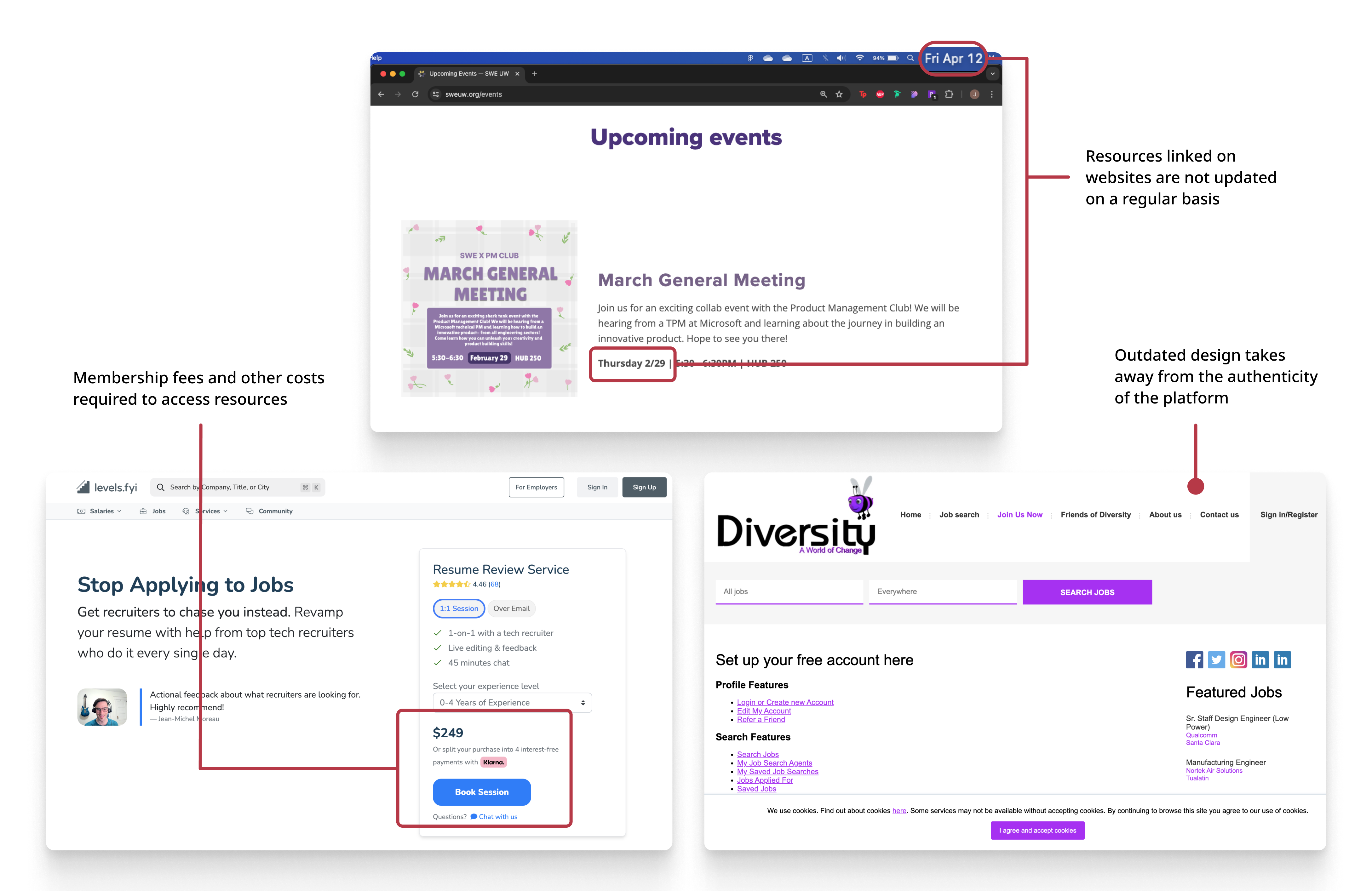
Competitive Analysis: Weaknesses
Highlighted Research Findings & Ideation
Based on the insights we uncovered in our research, our team generated a list of ideas and features to address our users' needs and pain points.
Students indicated that a website is their most utilized and preferred medium for accessing resources. Some students stated that a mobile app feels limiting, and they mainly access websites such as Indeed, Handshake, and the UW website, through desktop.

Use a website as a virtual extension of the LSAMP center. A website acts as the centralized location for students and staff to keep track of STEM resources as well as communications with other people using the platform.
Students and staff specified that one of the challenges they face is that many resources are not updated in current time. This prevents them from being able to get up-to-date information, and they may end up missing out on opportunities as a result.

Date log of updates on the platform indicates the resource information is accurate and up-to-date. Display current and upcoming happenings on a calendar.
When searching for STEM resources, students and staff faced issues when they had no way to contact the person who published the resource online - with no listed contact information, there was no way to learn more about the resource on the resource they were seeking out.
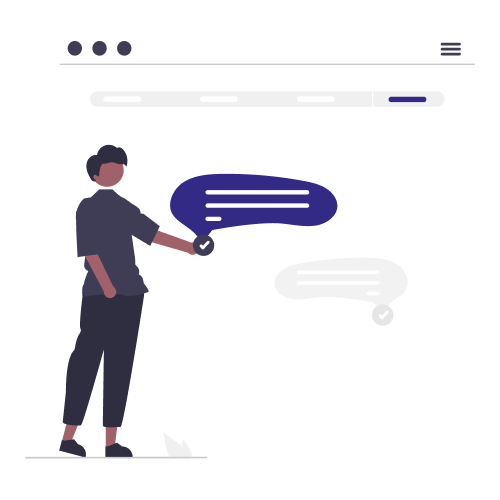
Provide clear contact information about who/where the resource came from to provide a point of contact if any questions arise.
Students had issues with resources being flat-out hard to find, causing them to go down a rabbit hole during their searches. This created frustration as they were unable to get the exact information they wanted and needed.

Organize searches in a conclusive and effective manner. Allow for filtering to streamline the search process and provide more conclusive search results.
Students and staff expressed desire for interpersonal relationships, which would enhance social engagement through networking opportunities, as well as provide accountability.

Community forums and messaging features to cultivate relationships and foster connections within between staff, students and organizations, creating opportunity for collaboration and networking.
Students look for resources that match their interests and majors. Additionally, staff emphasized the importance of highlighting students' diverse backgrounds, goals, and aspirations while seeking out STEM-related resources.

Personalized profile page to let students and staff choose which resources they are interested in and want to see on their page.
Using the brainstormed concept ideas, the resource hub website was sketched out first on paper, then wireframed as a low-fidelity prototype. For the full sketches and wireframes, see this document.
After our research and analysis, our team got in discussion with UW CERSE on project alignment. We decided that going forwards into the next phase of the project (prototyping the resource hub platform), our team would focus solely on the University of Washington due to time constraints for the capstone project. For future implementation of the STEM resource hub, other schools will be involved.
Iteration: Usability Testing & Hi-Fi Prototype
The wireframed flows underwent usability testing to gauge the intuitiveness of the flows and functional usability of the website prototype.
Based on feedback and recommendations from the testing, corresponding updates were made to the prototype. Brand color, images, detailed-components, and additional interactivity were implemented to transition to a higher-fidelity prototype. However, due to limited time, our team was unable to recruit and schedule additional usability testing for the high-fidelity prototype. Thus, we were unable to get feedback on and further refine our high-fidelity prototype before handing off to UW CERSE.
Challenge #01


before
Having many buttons and text on the landing screen created confusion, causing some participants to be overwhelmed as they did not know where to go first.
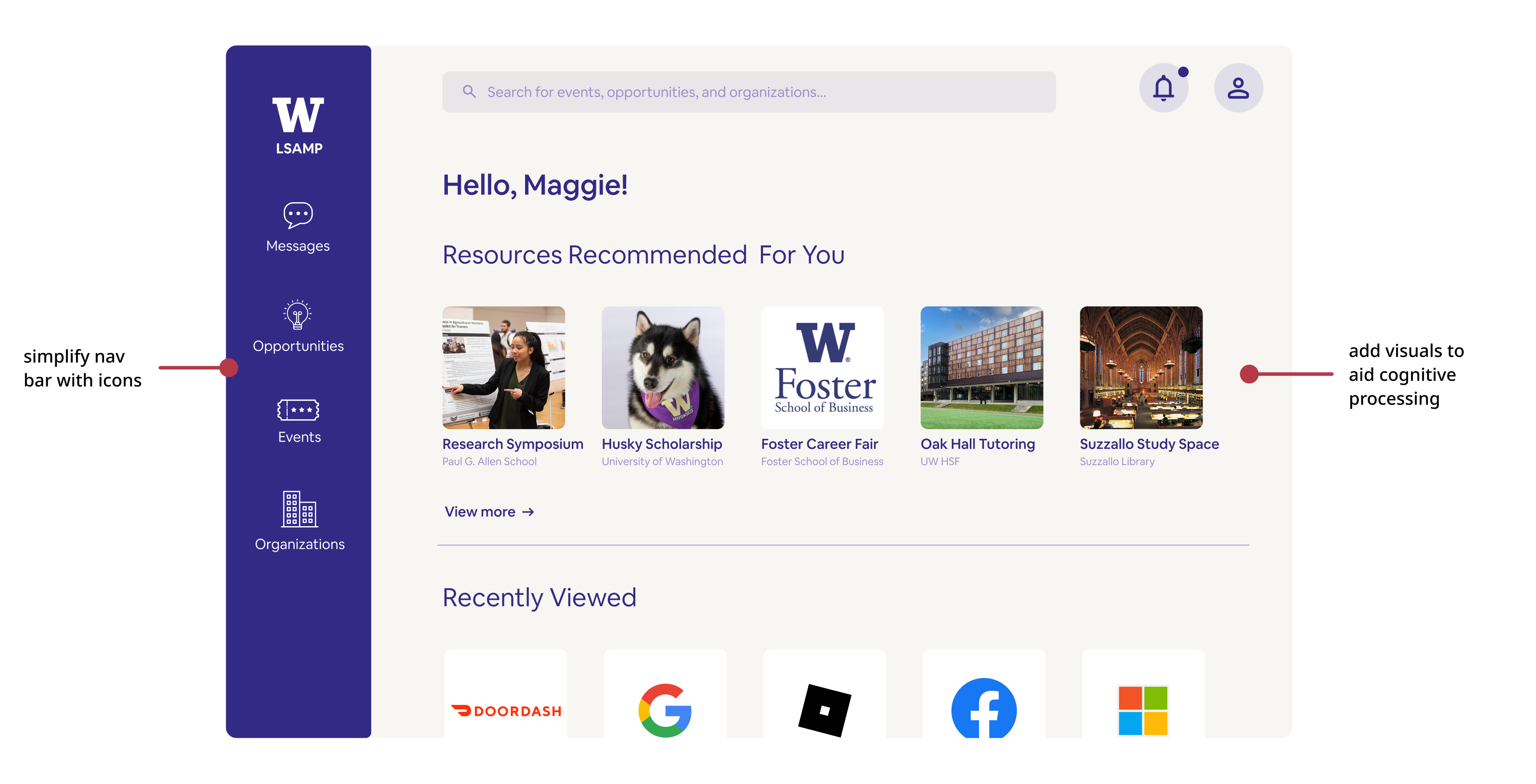
updated design
Reduce clutter on the landing page to lessen the cognitive load. Remove most of the text, replacing it with visuals to make actions more straightforward.
Challenge #02

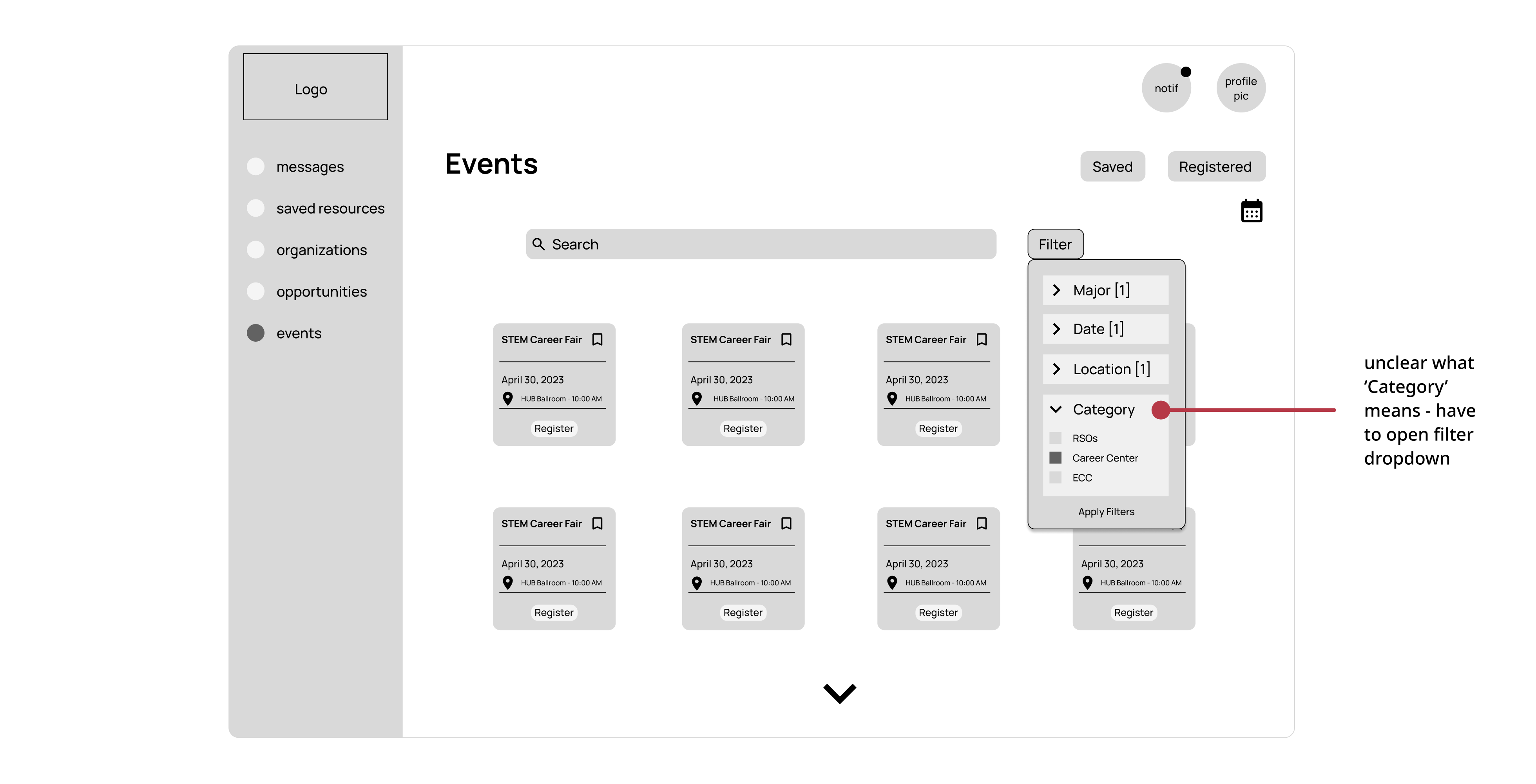
before
There was some confusion on certain button actions, specifically in Events filtering, as the wording was unclear. Participants also suggested separating out the filters to holistically see all filters that can be applied.
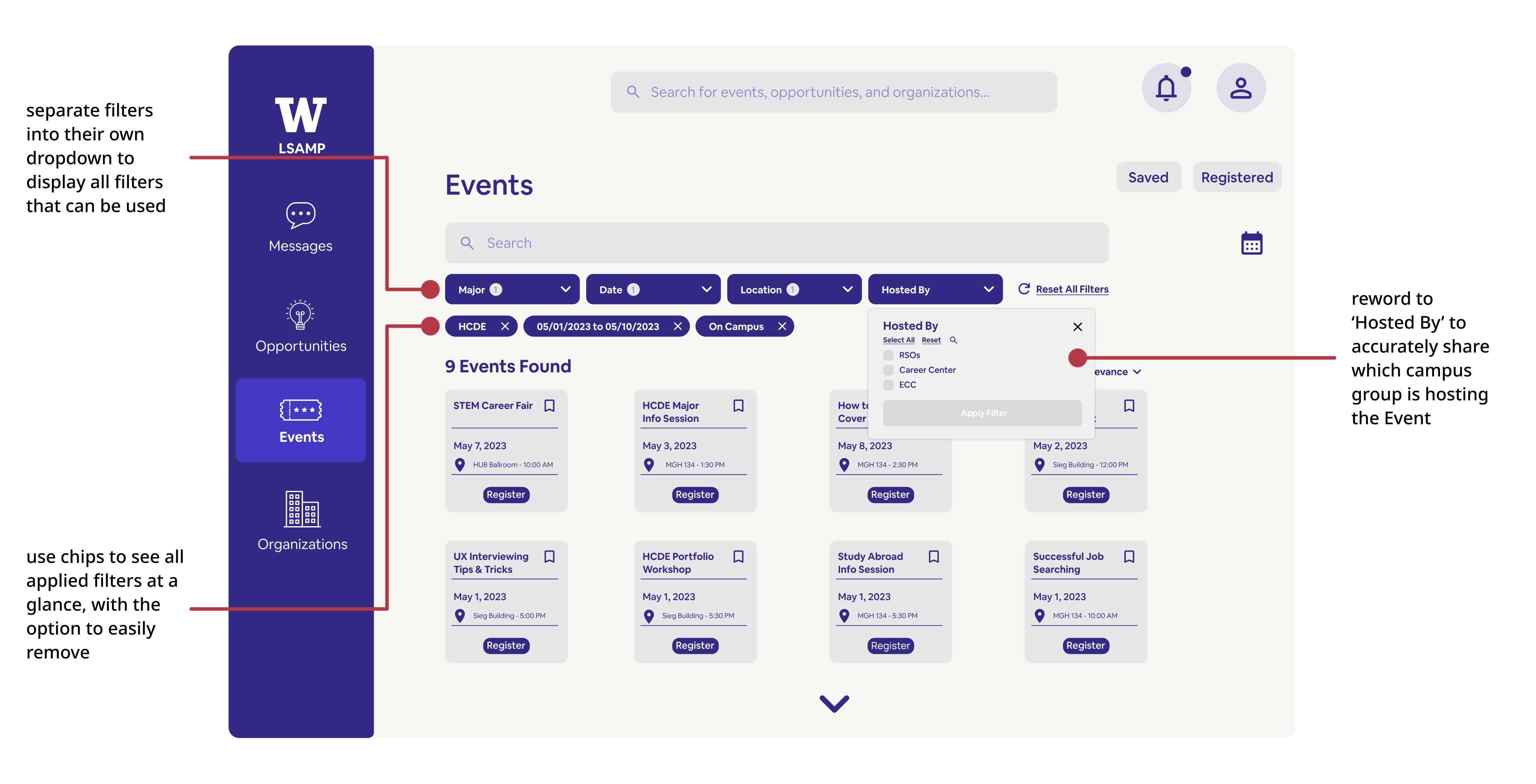
updated design
Reword the ambiguous buttons with specific language matching their actions, aiding in decision making for users. Separate filters into their own dropdowns to display all applicable filters.
Challenge #03

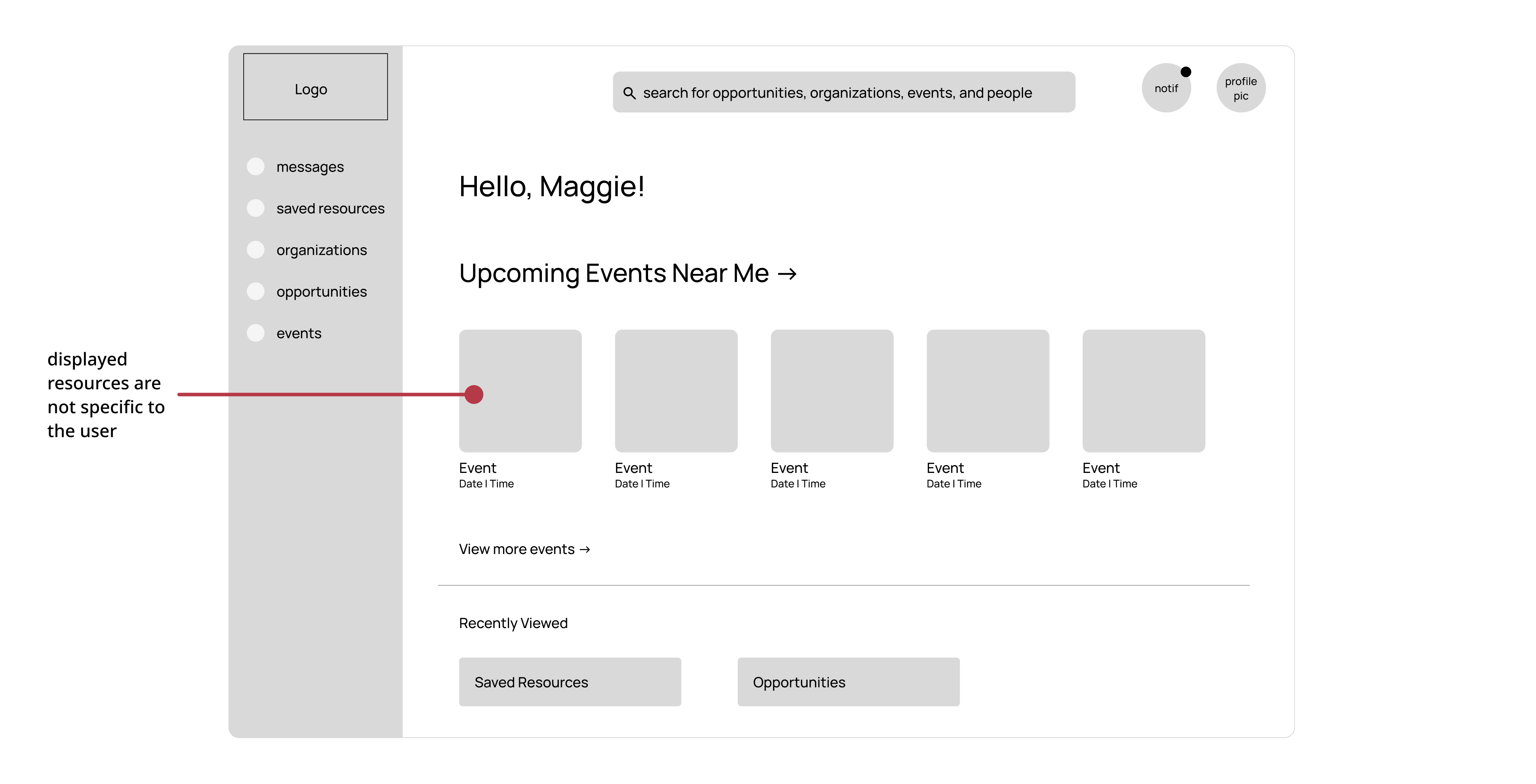
before
Participants suggested a helpful feature for finding STEM resources would be to show resources on the landing page based on their profile interests.

updated design
Display specific resources, such as internships, events, etc., on the landing page as 'Recommended for You' based on the user's interests or major.
Final Designs
Students have the ability to customize their profiles by adding keywords or resources they're interested in. On the homepage, tailored recommendations are showcased based on their profile preferences.

Filters can be applied when searching organizations, events, and opportunities to narrow the results. Dropdown filters are available, offering various categories for students to filter by, streamlining the search process.
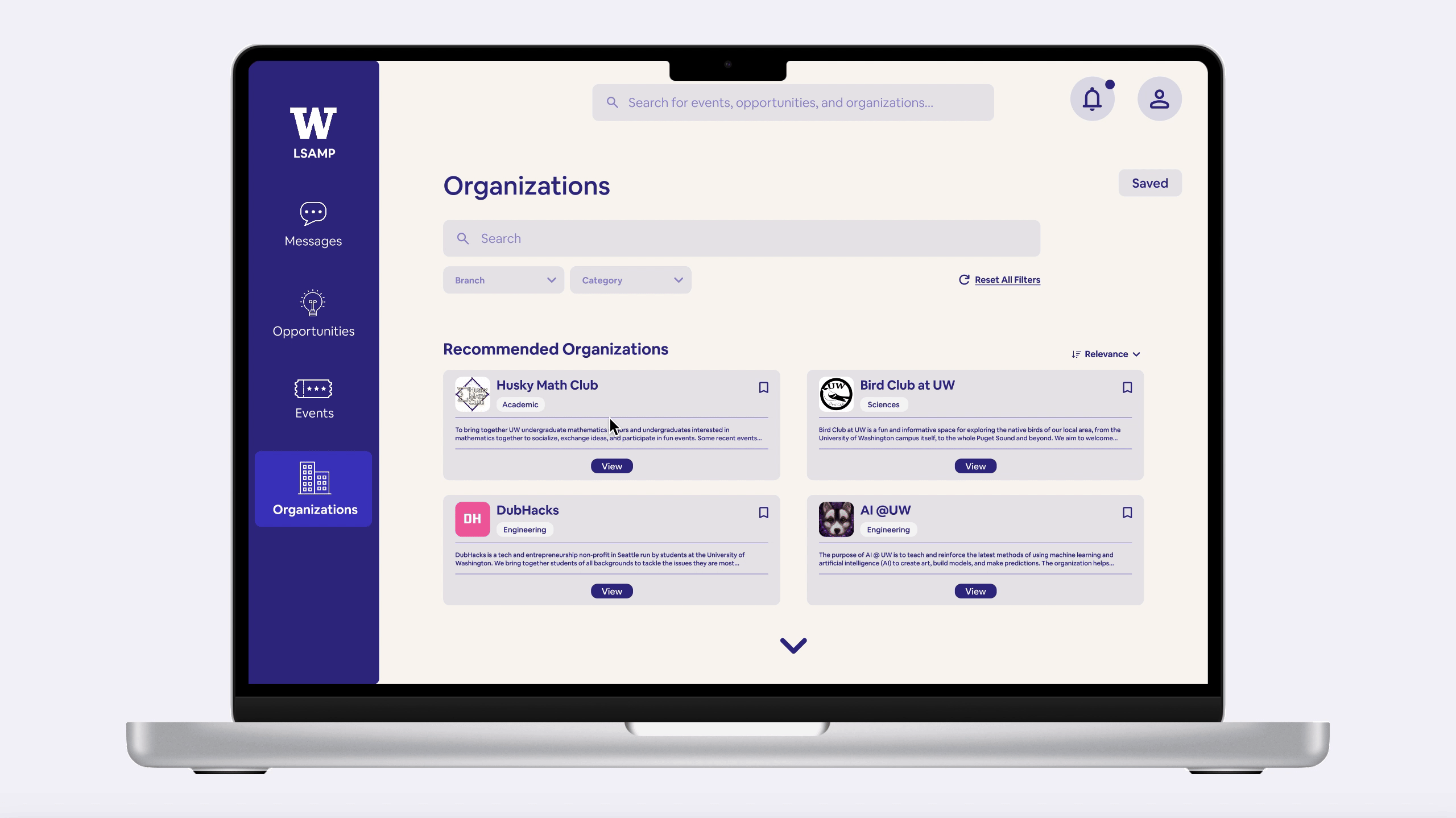
Staff can effortlessly distribute discovered resources directly students through the SERCH platform. With the platform's centralized system, staff can easily search for opportunities, events, and organizations and share them with students with just a click.
